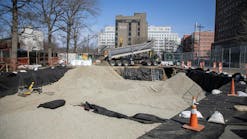About the author: Thomas J. Ryan is senior project manager, surface water, for Michael Baker Intl. Ryan can be reached at [email protected].
Thomas J. Ryan
undefinedUrban storm water modeling has evolved since the days of simplified rational method and Manning’s Equation. Spreadsheets and DOS-based programs for calculating existing capacity or proposed drainage systems quickly are becoming outdated. Current available storm water models use a much more advanced hydrodynamic calculation process than the traditional energy equation or pressure and momentum alone. Fully dynamic models using the shallow water equations or full Saint Venant equations allow engineers to evaluate complex drainage systems that include the effects of surcharge and backwater effects more accurately.
Urbanized areas can be evaluated using one-dimensional (1-D) storm drain systems and linear channels, two-dimensional (2-D) multidirectional surface runoff, or a combination of the two—a linked 1-D/2-D model. The complexity and sophistication of these models have developed substantially over the past 20 years and are becoming the norm for urban storm water modeling practices. One facet of these programs that has not developed as rapidly is the graphical representation of the calculated results. A shift in the industry is beginning to focus on identifying means to communicate complex modeling results in a manner easily interpreted by stakeholders or the general public.
Industry Shift
In most flood control projects, whether dealing with the impact of storm water flooding, sea levels rising along coastal areas, or dam and levee break analyses, many of the stakeholders do not have the technical backgrounds to fully comprehend today’s complex modeling results. In most cases, when dealing with local and federal agencies, the policymakers or voting public make the final funding decisions required to approve drainage improvement projects.
Traditional methods for conveying complex model results typically have included 2-D graphical exhibits and/or populated text summary tables. Most complex software models also include a 2-D animation option, which has been a valuable tool for the presentation of these model results. 2-D graphical result animation can work well for rural areas with low topographic relief, but for urbanized areas with extensive topographic relief, 2-D animation may not present the modeled data results effectively. For example, a common graphics application is to overlay 2-D results onto aerial photography. This creates an issue in urban areas if the orthographic aerial photograph was not taken directly above a project site, creating a skew in the image that does not match the detail-surveyed surface and resulting in holes in the graphics where buildings appear tilted. This issue typically occurs in larger models (e.g., a 1-sq-mile project area) where the aerial photograph is taken at one location.
With increasing demand for public awareness of the need for flood risk and hazard mitigation, these complex model results must be conveyed in a manner applicable to the project area as well as the target audience. For dense urban area modeling, graphical result presentations are venturing into 3-D graphics, especially animation.
New Developments
A few software companies are beginning to develop this technology. XP Software has partnered with Forum8 (VR-Design Studio), a Japanese firm, to develop a linking method in which 2-D hydraulic model results can be processed and animated in 3-D. Michael Baker Intl. has worked with both of these companies to refine the process and develop one of the first true 3-D animations of XPSWMM’s hydraulic storm water 2-D results in an urban setting. Project animations in Redlands, Calif., and at the World Trade Center in New York City have been successfully created to demonstrate flood hazard potentials for large rainstorm events, and coupled sea level rise and storm surge.
In both projects, several stakeholders exist, requiring a full understanding of the associated flood hazards and risks. The stakeholders range from government agencies to private landowners, city council members to the public, most of which comprise a non-technical audience. The 3-D animations served as a powerful tool to deliver the results of complex linked 1-D/2-D models.
With the advancements in comprehensive, complex storm water models, a method for conveying their results is becoming more important. As climate change predicts more damaging future storms, hurricanes and sea level rise, public awareness is becoming more critical. Whether it is the public or non-technical decision-makers and local stakeholders, flood hazard protection requires funding. Because most of the economic losses occur in populated urban areas, an appropriate method is required to show the potential risks associated with these hazards. 3-D animation is a valuable tool to deliver this message.
Download: Here






